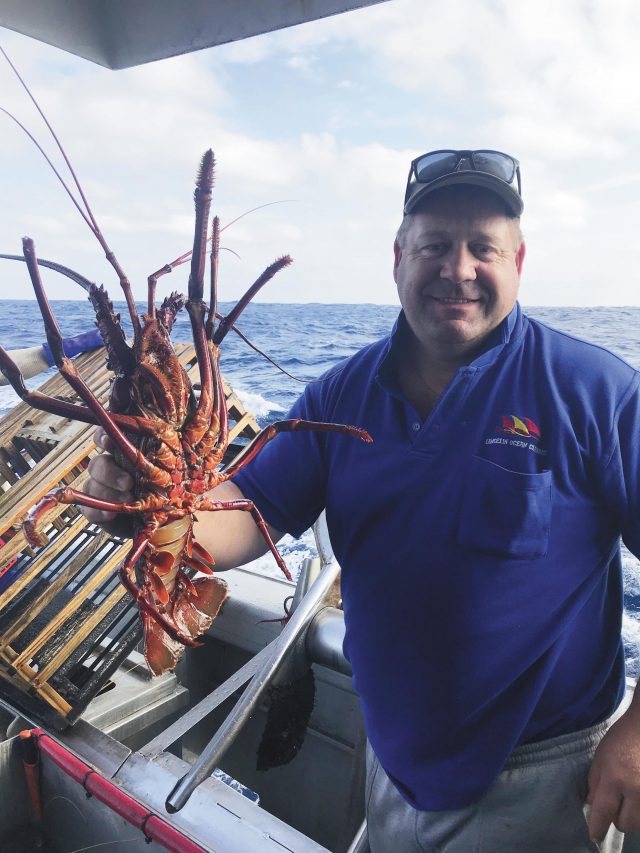The past 8 weeks have been a rollercoaster ride for Lancelin-based cray fisherman Clinton Moss – who became an accidental hero after diving head-first into the Rock Lobster Industry’s fight against the Government’s proposed changes to industry quotas.
On December 8, Fisheries Minister Dave Kelly announced a plan to increase the rock lobster quota by a staggering 27 per cent from 6,300 tonnes to 8,000 tonnes; with 17.3 per cent being retained by the government to lease or sell to the private sector. Fishermen reeled in shock as they struggled to comprehend both where the extra crays would come from and how this would affect already fluctuating prices.
It was particularly bad timing for Clint, who feared the forced changes would put him out of business. “I was hurting so much and looking for a place to put all my pain – so I shared my story on Facebook.”
Clint’s post went viral almost overnight, and as others backed him, his story snowballed. “I realised I was part of a huge network,” he said. “My story was like so many others up and down the coast.”
Fishing families banded together to make their fears known, arguing that the increased quota threatened both the sustainability and economic viability of the industry.
On 8 February this year, the Government backed down on the proposed changes, agreeing to further consult with industry on its plan to make more lobster available in the domestic market.
“The 1700 tonnes of extra rock lobster will not proceed,” Premier Mark McGowan said. “There will be 315 tonnes and most of that will go into the WA market.”
It was welcome news to Clint. “I’m smiling again now,” he said. His sentiment is echoed up and down the coast – although there is still some doubt and uncertainty underlying the welcome news.
“The unity of the fishery was key to winning the fight,” said Clint, who is now optimistic that an agreement can be reached. “The key to the next stage is to be unified and realistic.”
“At the moment we throw almost a third of our catch back,” explains Clint. “We keep the biggest crays – the ones we get the most for – and return the rest to the ocean to grow a bit more.” It’s a practice which also keeps the industry sustainable. “When we fish light, we let them grow – it makes everyone more money. It’s the perfect system – we’re empowering ourselves,” he says.
“When the whites run it’s our lowest price, so we hang back. But the recreational fishers are having the time of their lives!”
No-one knows better than the fishermen how to get the best out of their catch. Many have fished these waters for generations and their intuitive knowlege is valuable.
Clint took over his dad’s licences back in 1999, after 5 years trying his hand at ostrich farming in Mooliabeenee. Determined not to follow in his father’s footsteps, he ended up doing just that. “Nothing beats the buzz of the pot coming up and it’s full of crays,” he says. Life on the ocean certainly has it’s perks, and for those who can make it work crayfishing is an enviable lifestyle. But there’s plenty of hard work involved, and plenty of risks too – many financial.
“When I came back to fishing there were 81 boats in the bay – I was number 81. Now there’s only 22 (in Lancelin),” he said.
The Western Rock Lobster Fishery has fought many battles over the years and changing regulations along with environmental fluctuations have forced many out of business.
One thing that really muddied the water over recent months is the availability of of local lobster for locals to enjoy – it’s something the fishery would like to see improved too.
The Local Lobster Program allows commercial crayfishers to each catch and tag up to 100 extra crayfish for sale direct to locals between December and April.
But there’s a catch. The crays must be sold before the boat docks, creating a logistic nightmare for the boats.
“To solve this problem, my mate and I set up the Lanno Lobsters Facebook page,” says Clint, ever the entrepreneur. “This allows people to indicate what they want via the page, so we can tag the crays before the boat pulls in. The customers wait on the dock with their buckets!”
Other websites such as www.wacrays.com.au allow customers to buy live, fresh or frozen crays from the Geraldton or Welshpool depots.
Most boats use up their quota around Christmas, when demand is high. Others – who don’t have the inclination to fiddle with Facebook – sell the lot to a local restaurant or pub.
The system needs improvement – that’s something everyone agrees on.
After the flurry of Chinese New Year, when lobster prices rose as high as $72 per kilo, Clint is enjoying a few more days off now – as well as the calm after the storm. “We still fish, but we try not to get too much now, we wait until the winter.”
Discussions continue in Parliament this week and further consultation with industry will ideally find a solution that suits everyone.








